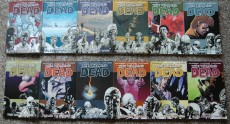Every so often, I re-examine the idea of trade paperbacks versus individual issues. Now that I’m helping out behind the scenes on a comic series (the aforementioned Stabbity Bunny), I’m encountering new questions regarding the unending question of trade paperbacks versus individual issues in a series.
I’ve mentioned in a previous column that I thought trades would be the end of the local comics shop. If people went to bookstores instead of their neighborhood comics store, I envisioned the end of things as we knew it. Fortunately, that didn’t turn out to be true.
But now I have new questions, and I’d like to examine them briefly with you this week.
HOW MANY ISSUES IN A TRADE PAPERBACK?
 In the past, when I bought trades, I never worried about it. If I looked at it and the price was good considering the number of pages, I bought it.
In the past, when I bought trades, I never worried about it. If I looked at it and the price was good considering the number of pages, I bought it.
Now we’re facing the question of what to put in the first Stabbity Bunny trade paperback. Issue three will be out by the end of the month, and Richard Rivera, who created the series, has been debating just what to put in that first collection.
Three issues? Four issues? Five? Even six? Trades are very helpful if someone hasn’t read the previous individual issues. I used to always buy trades to catch up on storylines if I missed a good tale, for instance.
Trades are often great ways to catch up on books I’ve only heard about but never had the chance to dive into before. These days, most stores buy just enough individual issues to sell through them, seems like. I’ve had to resort to trades or digital copies to catch up instead of finding previous issues.
Of course, we all have to live within our means, and we need to make decisions as to what we’ll buy and when. I see a lot of people buying trades during comics conventions when they have extra money to spend. I also do that when I’m at the local shop and have more money than comics. I love to ask the people who work there what they would recommend. I got into The Walking Dead that way – two trades and several individual issues at a store owned by a guy who really does a great job of matching taste to book.
The trick with a trade is that, if you’ve put your individual issues together, you don’t need to spend extra money on assembling the trade – you’ve got the goods already! Often, comics creators make a lot of their money on their trades, and it helps offset the cost of creating those previous issues.
You just have to price it right so someone considering the book will buy the trade and hopefully become a fan. How many issues will often depend on how much money you have left after your initial run of issues.
WHAT EXTRAS DO FANS LIKE?
 A couple of the things that will convince fans to buy the trade are extras, such as pin-ups or “how I made this book” written columns. Some folks like even copies of the scripts!
A couple of the things that will convince fans to buy the trade are extras, such as pin-ups or “how I made this book” written columns. Some folks like even copies of the scripts!
The important thing is to include at least a couple of things fans can’t get anywhere else, particularly in previous issues.
“Name” or great unknown artists doing pin-ups for you is a HUGE attraction! It does add to the cost of the trade, but it’s worth it when people are making the decision on whether to buy your trade or not.
I’m not as big a fan of scripts. I mean, I write them or edit them, but if a script has been turned into a comic, I’m much more interested in how it turned out. However, if you’re considering making your own comics, having one of these babies available to you can really be helpful as you’re learning the process. What did the writer put on paper that inspired the artist, for instance? How did they do that?
What’s coming up in future issues can be a great tease as well. Usually when a trade is printed, you’re deep into the upcoming books, so you can give ideas what the fan will see in the near future. Personally, I like that a lot!
If you didn’t have the comic printed on glossy (shiny) paper, printing your trade on that kind of stock can make the story leap off the page. Highly recommended!
Another thing to add is color, particularly if your book came out in black and white. I loved Jeff Smith’s Bone, bought all the black-and-white issues, but went nuts when he printed a full-color series of trades! I still love those!
Just don’t let too much time pass between the issues in your trade and when it hits the stand. Some creators have enough devoted fans who will wait, but some people just forget a book that they bought a while back. Not everyone is Frank Miller making The Dark Knight Returns, for example!
KEEP THE FOCUS ON THE FANS
 When it comes to pricing a trade, you should always make sure your book is a good deal! I’ve seen Image set the cost of a trade significantly lower than the individual issues, and I’m sure fans (like me) appreciated that!
When it comes to pricing a trade, you should always make sure your book is a good deal! I’ve seen Image set the cost of a trade significantly lower than the individual issues, and I’m sure fans (like me) appreciated that!
What’s really helpful is letting the creator or creators of a series you love know what you’d like to see in a trade. With social media, you can often find a way to communicate with them and let your opinions be known. Think an artist would be a good choice for a pin-up? Let the creator know! He or she might not have considered that person before!
It depends on my love of the content whether I want a hardcover or softcover version. There have been many wonderful stories I want to be sure I have in a long-lived edition so I can read them over and over again. Some, not so much!
Do you have other suggestions for trades that you’d like to see? Be sure to share your ideas below so any creators reading this column can consider them! You might improve the trades of the future in ways others haven’t considered!



